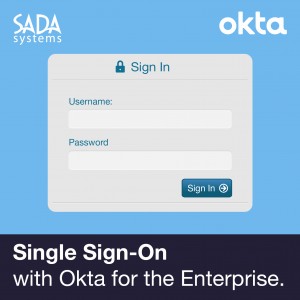
In today’s identity management climate, single sign-on (SSO) capability is critical to the success of enterprise identity and access management (IAM). IT departments face growing demands: managing thousands of users, both internal and external, who each need access to an increasing number of cloud-based applications. Adding to this complexity is the fact that these users need this access at any time, wherever they may be, and on whichever device they choose.
On top of that, there are now millions of apps that could be streamlining your team’s operations. Innovation is constant, but teams can be limited to a select number of tools based on the overhead time it takes to set them up, ensure proper security protocols, and get users on-boarded. SSO with Okta helps streamline this. Whether it’s provisioning, meeting compliance requirements, or simply reducing the number of help desk calls, SSO plays an integral role in efficient enterprise IAM. Here are some of the ways a single sign-on solution makes a true impact on your company’s productivity:
A Solution as Versatile as Your Team
More than ever, users need a quick and secure way to access cloud-based tools to work. If there is no centralized IAM, accessing the software becomes a time-consuming process, with employees having to manually log into each app or service they require. Imagine the alternative: anyone who logs in to their Okta dashboard—whether on-prem, remotely on a laptop, or on mobile—immediately has access to all their applications. This could be Office 365, G Suite Apps, DocuSign, or any of over 5,000 other apps currently in the Okta Application Network. No more manual log-ins. No more forgotten passwords. No more password resets on an ever-increasing scale.
Peace of Mind that Your Network is Secure
A single sign-on solution also gives IT teams a real-time overview of the users that accessed certain applications, when that access occurred, and other important information about their activity. This information helps ensure the integrity of enterprise IAM security. This is done through a real-time system log that includes geolocation tracking, access reports and integration with SIEMs. Other common security risks can be addressed through single sign-on. For example, if an employee loses a laptop or cell phone with a password automatically stored in the devices, an IT team can efficiently disable access to the user’s account.
A Team That is Always on Track
With so many moving parts, having a single point of authentication simplifies what could be overwhelmingly complex. It comes down to streamlining the day-to-day operations of your team so they can focus on what they do best—while only ever having to sign in once. And instead of having an IT team that’s tied up with low-level administrative issues, such as addressing help tickets or deploying tools for disparate users and teams, these processes are automated and the team is empowered to focus on the bigger picture—efficiency, security and scale.As an Okta Partner, SADA Systems can walk you through your enterprise identity and access management.



